Threat Model
This section presents a threat model for Cilium. This threat model allows interested parties to understand:
security-specific implications of Cilium’s architecture
controls that are in place to secure data flowing through Cilium’s various components
recommended controls for running Cilium in a production environment
Scope and Prerequisites
This threat model considers the possible attacks that could affect an up-to-date version of Cilium running in a production environment; it will be refreshed when there are significant changes to Cilium’s architecture or security posture.
This model does not consider supply-chain attacks, such as attacks where a malicious contributor is able to intentionally inject vulnerable code into Cilium. For users who are concerned about supply-chain attacks, Cilium’s security audit assessed Cilium’s supply chain controls against the SLSA framework.
In order to understand the following threat model, readers will need familiarity with basic Kubernetes concepts, as well as a high-level understanding of Cilium’s architecture and components.
Methodology
This threat model considers eight different types of threat actors, placed at different parts of a typical deployment stack. We will primarily use Kubernetes as an example but the threat model remains accurate if deployed with other orchestration systems, or when running Cilium outside of Kubernetes. The attackers will have different levels of initial privileges, giving us a broad overview of the security guarantees that Cilium can provide depending on the nature of the threat and the extent of a previous compromise.
For each threat actor, this guide uses the the STRIDE methodology to assess likely attacks. Where one attack type in the STRIDE set can lead to others (for example, tampering leading to denial of service), we have described the attack path under the most impactful attack type. For the potential attacks that we identify, we recommend controls that can be used to reduce the risk of the identified attacks compromising a cluster. Applying the recommended controls is strongly advised in order to run Cilium securely in production.
Reference Architecture
For ease of understanding, consider a single Kubernetes cluster running Cilium, as illustrated below:
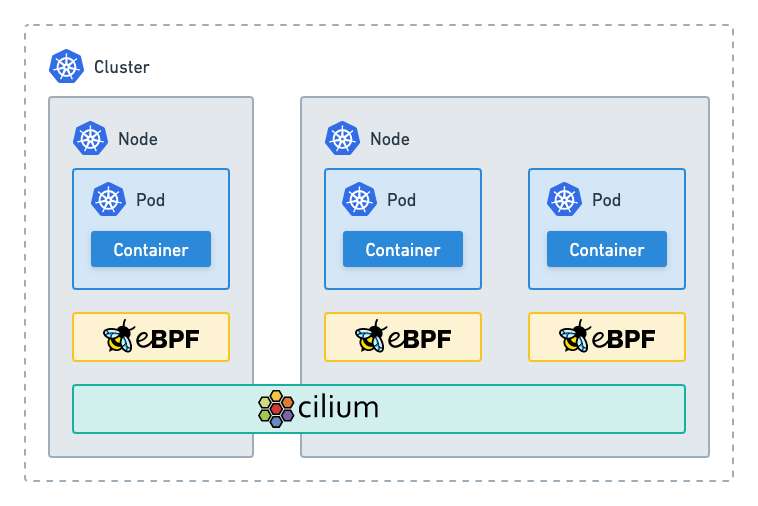
The Threat Surface
In the above scenario, the aim of Cilium’s security controls is to ensure that all the components of the Cilium platform are operating correctly, to the extent possible given the abilities of the threat actor that Cilium is faced with. The key components that need to be protected are:
the Cilium agent running on a node, either as a Kubernetes pod, a host process, or as an entire virtual machine
Cilium state (either stored via CRDs or via an external key-value store like etcd)
eBPF programs loaded by Cilium into the kernel
network packets managed by Cilium
observability data collected by Cilium and stored by Hubble
The Threat Model
For each type of attacker, we consider the plausible types of attacks available to them, how Cilium can be used to protect against these attacks, as well as the security controls that Cilium provides. For attacks which might arise as a consequence of the high level of privileges required by Cilium, we also suggest mitigations that users should apply to secure their environments.
Kubernetes Workload Attacker
For the first scenario, consider an attacker who has been able to gain access to a Kubernetes pod, and is now able to run arbitrary code inside a container. This could occur, for example, if a vulnerable service is exposed externally to a network. In this case, let us also assume that the compromised pod does not have any elevated privileges (in Kubernetes or on the host) or direct access to host files.

In this scenario, there is no potential for compromise of the Cilium stack; in fact, Cilium provides several features that would allow users to limit the scope of such an attack:
Threat surface |
Identified STRIDE threats |
Cilium security benefits |
|---|---|---|
Cilium agent |
Potential denial of service if the compromised Kubernetes workload does not have defined resource limits. |
Cilium can enforce bandwidth limitations on pods to limit the network resource utilization. |
Cilium configuration |
None |
|
Cilium eBPF programs |
None |
|
Network data |
None |
|
Observability data |
None |
Cilium’s Hubble flow-event observability can be used to provide reliable audit of the attacker’s L3/L4 and L7 network connectivity. |
Recommended Controls
Kubernetes workloads should have defined resource limits. This will help in ensuring that Cilium is not starved of resources due to a misbehaving deployment in a cluster.
Cilium can be given prioritized access to system resources either via Kubernetes, cgroups, or other controls.
Runtime security solutions such as Tetragon should be deployed to ensure that container compromises can be detected as they occur.
Limited-privilege Host Attacker
In this scenario, the attacker is someone with the ability to run arbitrary code with direct access to the host PID or network namespace (or both), but without “root” privileges that would allow them to disable Cilium components or undermine the eBPF and other kernel state Cilium relies on.
This level of access could exist for a variety of reasons, including:
Pods or other containers running in the host PID or network namespace, but not with “root” privileges. This includes
hostNetwork: trueandhostPID: truecontainers.Non-“root” SSH or other console access to a node.
A containerized workload that has “escaped” the container namespace but as a non-privileged user.
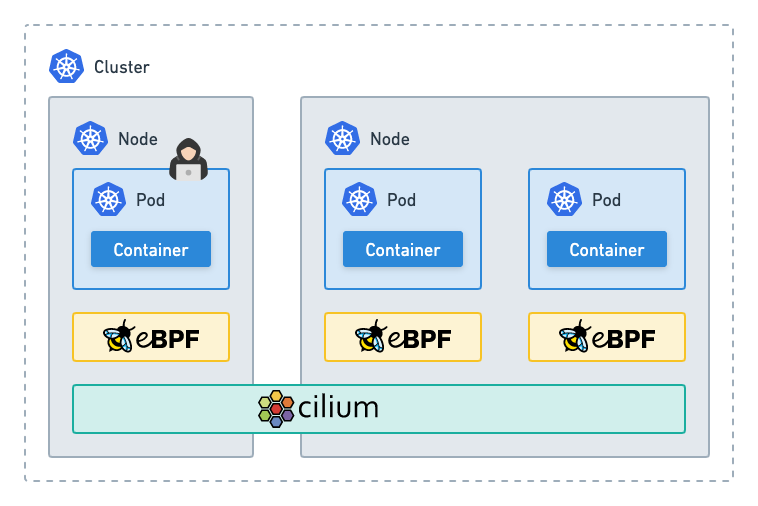
In this case, an attacker would be able to bypass some of Cilium’s network controls, as described below:
Threat surface |
Identified STRIDE threats |
Cilium security benefits |
|---|---|---|
Cilium agent |
|
|
Cilium configuration |
Same as for the Cilium agent. |
|
Cilium eBPF programs |
Same as for the Cilium agent. |
|
Network data |
Elevation of privilege: traffic sent by the attacker will no longer be subject to Kubernetes or container-networked Cilium network policies. Host-networked Cilium policies will continue to apply. Other traffic within the cluster remains unaffected. |
Cilium’s network connectivity will prevent an attacker from observing the traffic intended for other workloads, or sending traffic that spoofs the identity of another pod, even if transparent encryption is not in use. |
Observability data |
None |
Cilium’s Hubble flow-event observability can be used to provide reliable audit of the attacker’s L3/L4 and L7 network connectivity. Traffic sent by the attacker will be attributed to the worker node, and not to a specific Kubernetes workload. |
Recommended Controls
In addition to the recommended controls against the Kubernetes Workload Attacker:
Container images should be regularly patched to reduce the chance of compromise.
Minimal container images should be used where possible.
Host-level privileges should be avoided where possible.
Ensure that the container users do not have access to the underlying container runtime.
Root-equivalent Host Attacker
A “root” privilege host attacker has full privileges to do everything on the local host. This access could exist for several reasons, including:
Root SSH or other console access to the Kubernetes worker node.
A containerized workload that has escaped the container namespace as a privileged user.
Pods running with
privileged: trueor other significant capabilities likeCAP_SYS_ADMINorCAP_BPF.
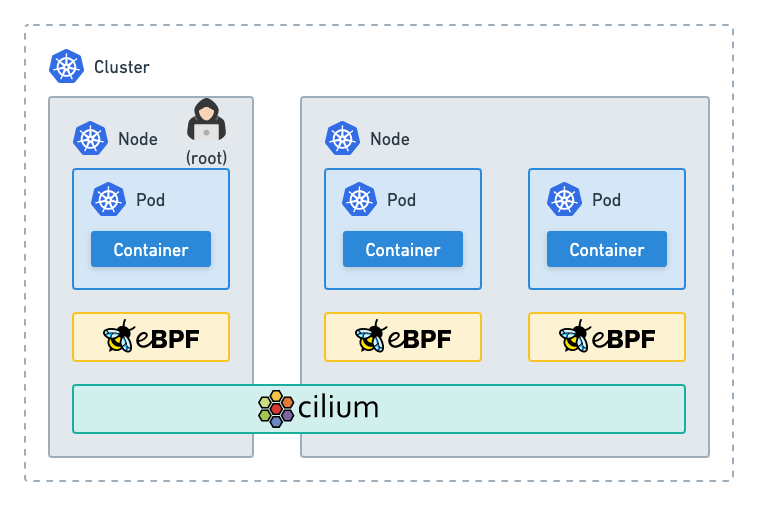
Threat surface |
Identified STRIDE threats |
|---|---|
Cilium agent |
In this situation, all potential attacks covered by STRIDE are possible. Of note:
|
Cilium configuration |
|
Cilium eBPF programs |
|
Network data |
|
Observability data |
This attack scenario emphasizes the importance of securing Kubernetes nodes, minimizing the permissions available to container workloads, and monitoring for suspicious activity on the node, container, and API server levels.
Recommended Controls
In addition to the controls against a Limited-privilege Host Attacker:
Workloads with privileged access should be reviewed; privileged access should only be provided to deployments if essential.
Network policies should be configured to limit connectivity to workloads with privileged access.
Kubernetes audit logging should be enabled, with audit logs being sent to a centralized external location for automated review.
Detections should be configured to alert on suspicious activity.
cilium-operatorpods should not be scheduled on nodes that run regular workloads, and should instead be configured to run on control plane nodes.
Man-in-the-middle Attacker
In this scenario, our attacker has access to the underlying network between Kubernetes worker nodes, but not the Kubernetes worker nodes themselves. This attacker may inspect, modify, or inject malicious network traffic.
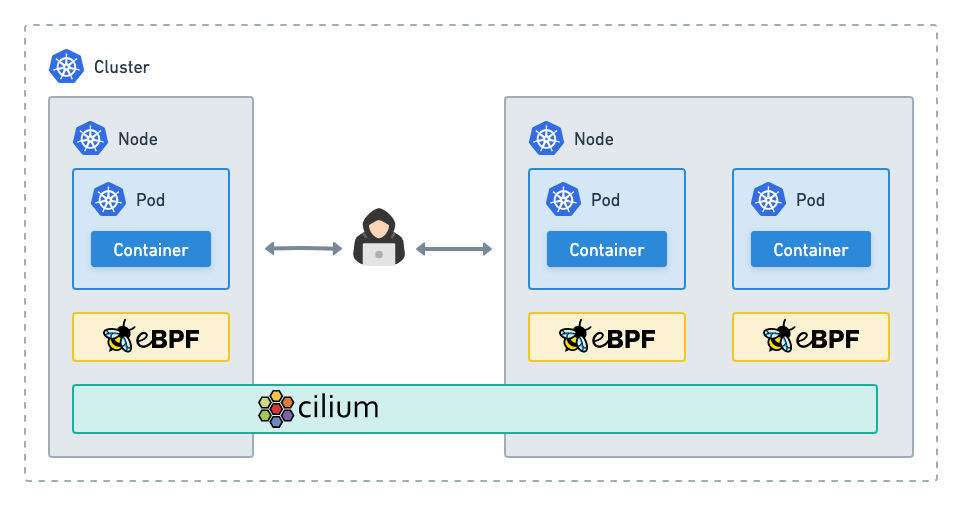
The threat matrix for such an attacker is as follows:
Threat surface |
Identified STRIDE threats |
|---|---|
Cilium agent |
None |
Cilium configuration |
None |
Cilium eBPF programs |
None |
Network data |
|
Observability data |
|
Recommended Controls
Transparent Encryption should be configured to ensure the confidentiality of communication between workloads.
TLS should be configured for communication between the Prometheus metrics endpoints and the Prometheus server.
Network policies should be configured such that only the Prometheus server is allowed to scrape Hubble metrics in particular.
Network Attacker
In our threat model, a generic network attacker has access to the same underlying IP network as Kubernetes worker nodes, but is not inline between the nodes. The assumption is that this attacker is still able to send IP layer traffic that reaches a Kubernetes worker node. This is a weaker variant of the man-in-the-middle attack described above, as the attacker can only inject traffic to worker nodes, but not see the replies.
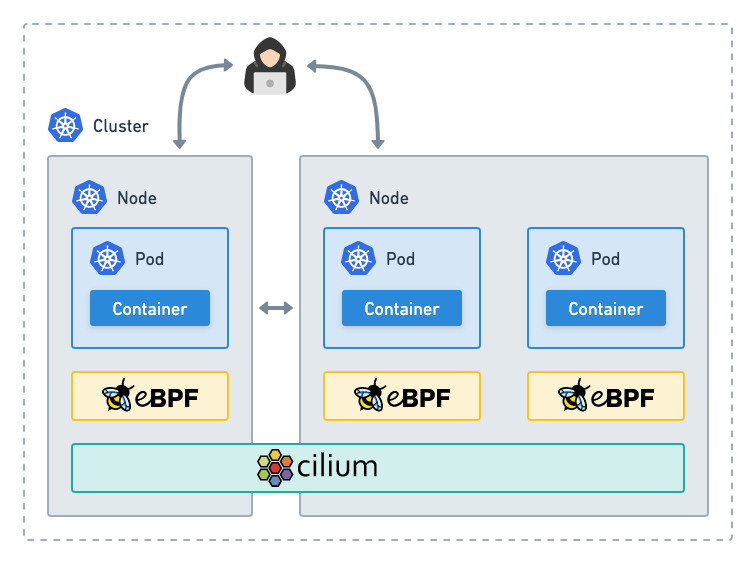
For such an attacker, the threat matrix is as follows:
Threat surface |
Identified STRIDE threats |
|---|---|
Cilium agent |
None |
Cilium configuration |
None |
Cilium eBPF programs |
None |
Network data |
|
Observability data |
|
Recommended Controls
Transparent Encryption should be configured to ensure the confidentiality of communication between workloads.
Kubernetes API Server Attacker
This type of attack could be carried out by any user or code with network access to the Kubernetes API server and credentials that allow Kubernetes API requests. Such permissions would allow the user to read or manipulate the API server state (for example by changing CRDs).
This section is intended to cover any attack that might be exposed via Kubernetes API server access, regardless of whether the access is full or limited.
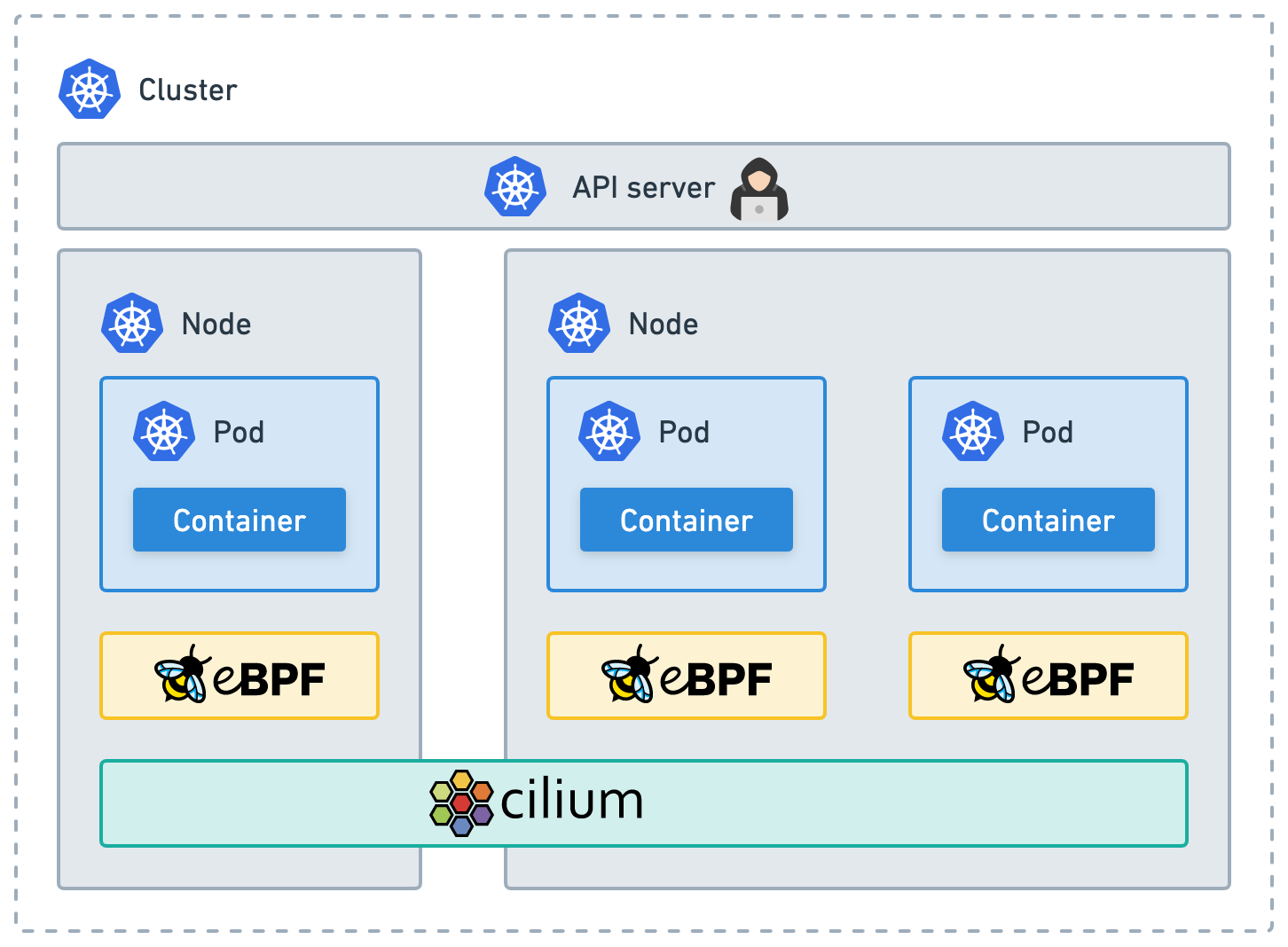
For such an attacker, our threat matrix is as follows:
Threat surface |
Identified STRIDE threats |
|---|---|
Cilium agent |
|
Cilium configuration |
The ability to modify the
The cumulative effect of such actions could result in the escalation of a single-node compromise into a multi-node compromise. |
Cilium eBPF programs |
An attacker with |
Network data |
Privileged Kubernetes API server access ( |
Observability data |
Users with permissions to configure workload settings could cause denial of service. |
Recommended Controls
Kubernetes RBAC should be configured to only grant necessary permissions to users and service accounts. Access to resources in the
kube-systemandciliumnamespaces in particular should be highly limited.Kubernetes audit logs should be used to automatically review requests made to the API server, and detections should be configured to alert on suspicious activity.
Cilium Key-value Store Attacker
Cilium can use an external key-value store such as etcd to store state. In this scenario, we consider a user with network access to the Cilium etcd endpoints and credentials to access those etcd endpoints. The credentials to the etcd endpoints are stored as Kubernetes secrets; any attacker would first have to compromise these secrets before gaining access to the key-value store.
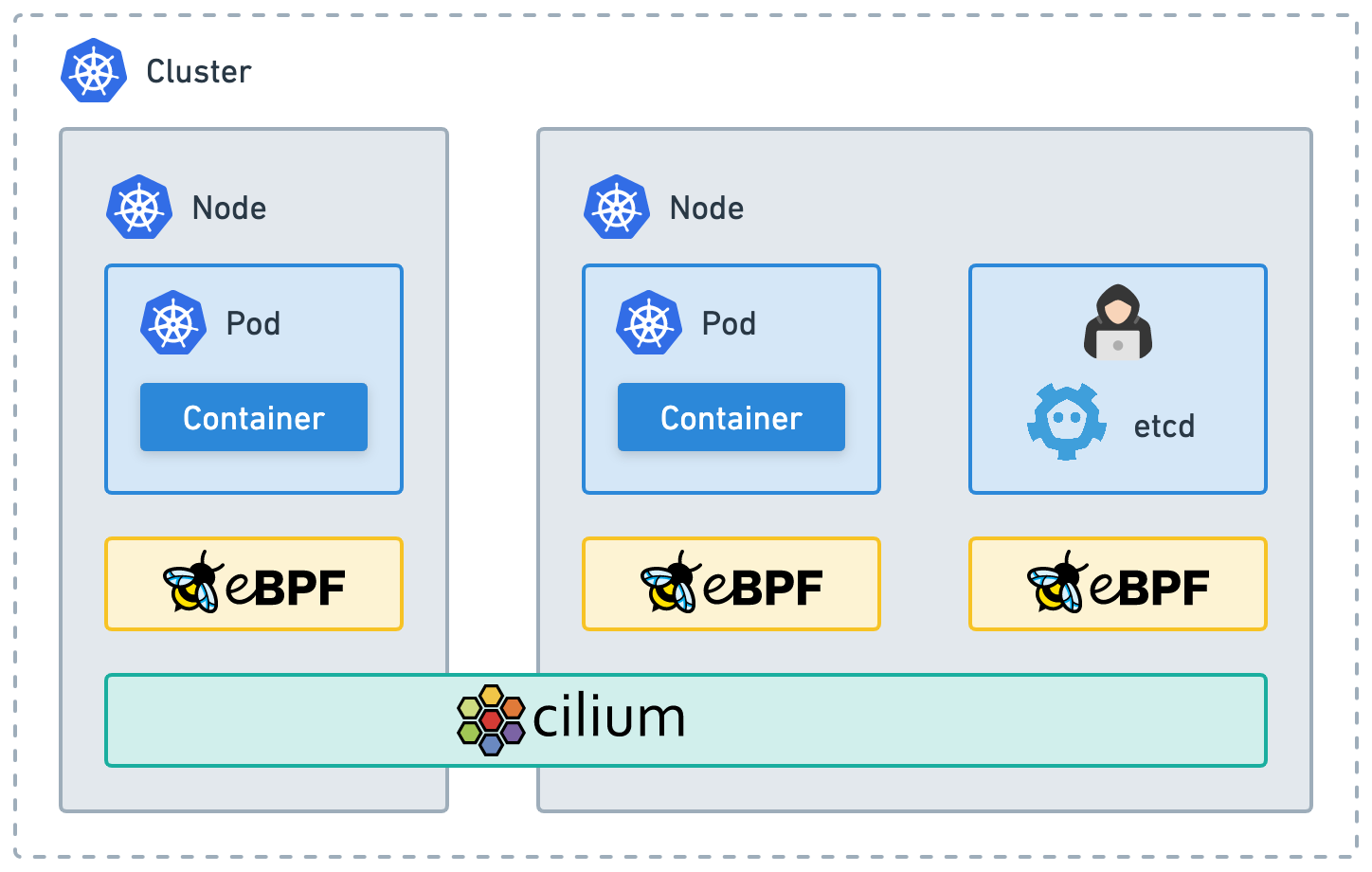
Threat surface |
Identified STRIDE threats |
|---|---|
Cilium agent |
None |
Cilium configuration |
The ability to create or modify Identities or Endpoints in etcd would allow an attacker to “give” any pod any identity. The ability to spoof identities in this manner might be used to escalate a single node compromise to a multi-node compromise, for example by spoofing identities to undermine ingress segmentation rules that would be applied on remote nodes. |
Cilium eBPF programs |
None |
Network data |
An attacker would be able to modify the routing of traffic within a cluster, and as a consequence gain the privileges of a Man-in-the-middle Attacker. |
Observability data |
None |
Recommended Controls
The
etcdinstance deployed to store Cilium configuration should be independent of the instance that is typically deployed as part of configuring a Kubernetes cluster. This separation reduces the risk of a Ciliumetcdcompromise leading to further cluster-wide impact.Kubernetes RBAC controls should be applied to restrict access to Kubernetes secrets.
Kubernetes audit logs should be used to detect access to secret data and alert if such access is suspicious.
Hubble Data Attacker
This is an attacker with network reachability to Kubernetes worker nodes, or other systems that store or expose Hubble data, with the goal of gaining access to potentially sensitive Hubble flow or process data.
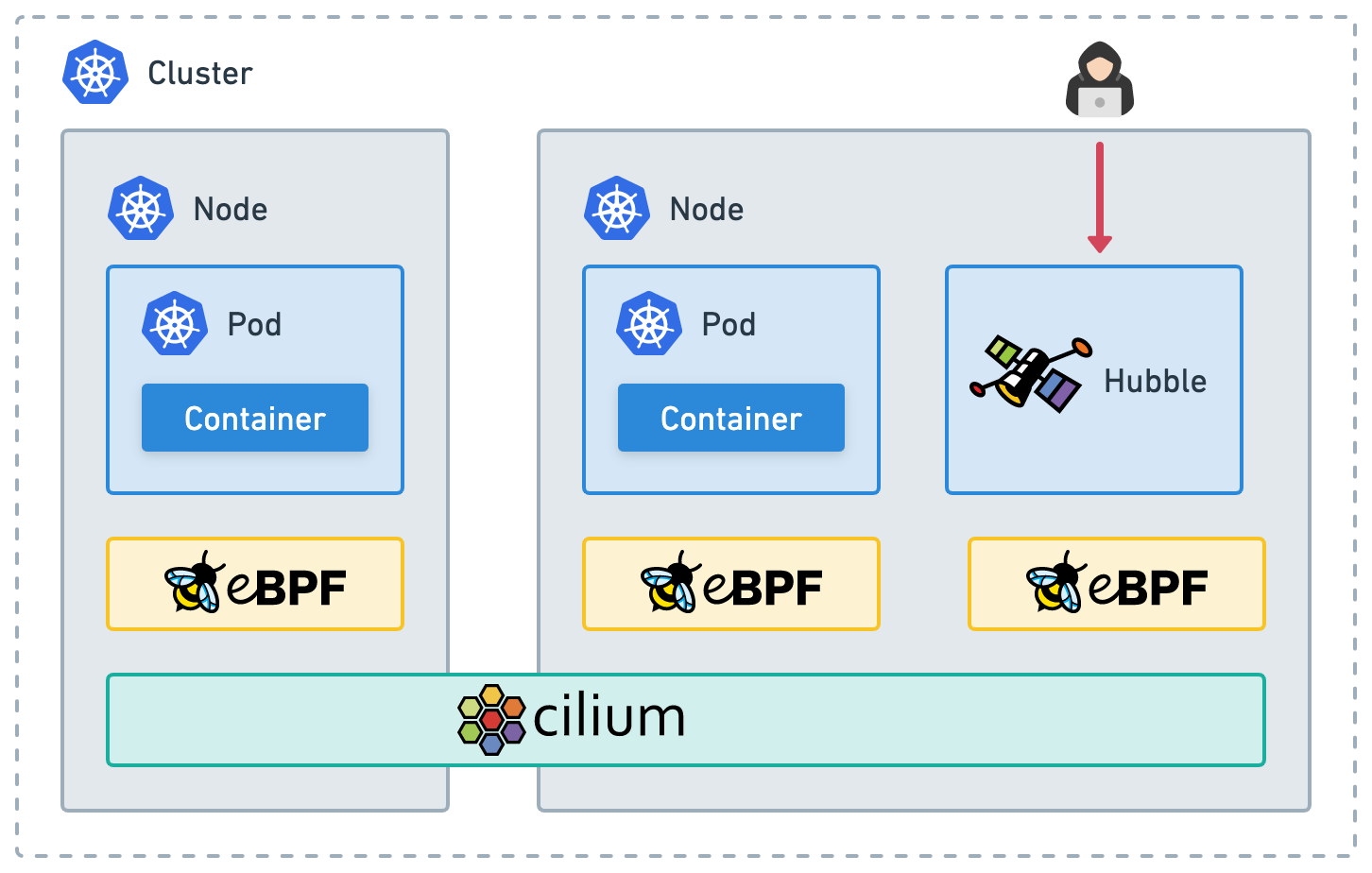
Threat surface |
Identified STRIDE threats |
|---|---|
Cilium pods |
None |
Cilium configuration |
None |
Cilium eBPF programs |
None |
Network data |
None |
Observability data |
None, assuming correct configuration of the following:
|
Recommended Controls
Network policies should limit access to the
hubble-relayandhubble-uiservicesKubernetes RBAC should be used to limit access to any
cilium-*orhubble-`*podsTLS should be configured for access to the Hubble Relay API and Hubble UI
TLS should be correctly configured for any data export
The destination data stores for exported data should be secured (such as by applying encryption at rest and cloud provider specific RBAC controls, for example)
Overall Recommendations
To summarize the recommended controls to be used when configuring a production Kubernetes cluster with Cilium:
Ensure that Kubernetes roles are scoped correctly to the requirements of your users, and that service account permissions for pods are tightly scoped to the needs of the workloads. In particular, access to sensitive namespaces,
execactions, and Kubernetes secrets should all be highly controlled.Use resource limits for workloads where possible to reduce the chance of denial of service attacks.
Ensure that workload privileges and capabilities are only granted when essential to the functionality of the workload, and ensure that specific controls to limit and monitor the behavior of the workload are in place.
Use network policies to ensure that network traffic in Kubernetes is segregated.
Use Transparent Encryption in Cilium to ensure that communication between workloads is secured.
Enable Kubernetes audit logging, forward the audit logs to a centralized monitoring platform, and define alerting for suspicious activity.
Enable TLS for access to any externally-facing services, such as Hubble Relay and Hubble UI.
Use Tetragon as a runtime security solution to rapidly detect unexpected behavior within your Kubernetes cluster.
If you have questions, suggestions, or would like to help improve Cilium’s security posture, reach out to security@cilium.io.